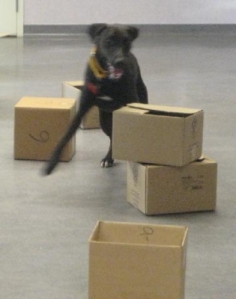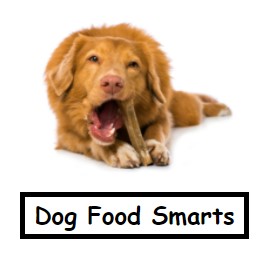In “Thyroid on Trial” we used an evidence pyramid to examine the various types of scientific studies that have been used to examine the hypothesis that there is a connection between hypothyroidism and aggressive behavior in dogs. We followed this example up through most of the levels of the pyramid, finishing at the penultimate level, the randomized, controlled trial.
At the tippy top of the evidence pyramid is the systematic review. As I mentioned in that piece, systematic reviews are somewhat of a rarity in canine science because they entail an enormous amount of work and time and because such reviews are only possible once there is a robust body of published information about a topic. So, I was recently quite delighted to find a newly published systematic review of a topic that many dog folks have an interest in – Canine Scenting Ability.
WHAT DOES THE NOSE KNOW?
It is generally accepted that dogs possess a phenomenal sense of smell. These talents are regularly demonstrated in the many ways that dogs work and play at various scenting tasks. Dogs are trained to find illicit drugs, explosives, and land mines for the police and military, to identify the presence of mold, insects and toxins in homes and public buildings, and in recent years, to diagnose the presence of cancerous tumors or changes in blood glucose levels in human patients. On the recreation side of things, anyone who enjoys tracking or canine nose work with their dog knows that these canine sports are not only interesting and enjoyable for owners, but are great fun for the dogs as well.
Evidence in support of the dog’s keen scenting ability comes from many sources, each of which is associated with varying degrees of reliability. Information ranges from anecdotes (“Fluffy detected Aunt Marge’s diabetes and saved her life!”), to media reports of heroic finds and rescues, to controlled scientific studies. The diversity of the dog’s olfactory talents is also expressed by the wide range of items that dogs can be trained to locate and identify.
The Systematic Review: Knowing this, a group of researchers at Freie University’s College of Veterinary Medicine in Berlin, Germany conducted a systematic review of all of the published research regarding the domestic dog’s ability to successfully detect selected odors. They published their results in the peer-reviewed journal, Applied Animal Behaviour Science. Here is what they found:
- Papers: A group of 31 papers was initially identified. Of these, 2 were excluded for duplication and 14 were excluded because they did not meet the criteria for a systematic review (i.e. they did not include original research). This left 14 published studies for the review.
- Odor substrates: Biological substances were used in all of the studies. These included termites/ants (2), cancers (7), tree snakes (1), microbial growth (1), parasitic infection (1), bird/bat carcasses (1), and estrus in cows (1).
- Training methods: All of the studies used reward-based training methods. Five of the papers specifically mentioned that clicker training was used. One paper reported that using positive reinforcement to train dogs resulted in greater sensitivity to the test compound than that observed in an earlier study that had used aversive stimuli to train dogs to detect the same compound.
- Duration of training : Training period durations ranged from just a week to more than a year. While the authors assumed that more difficult tasks or training dogs with no previous training may have resulted in the more extended training periods, this was difficult to ascertain given the small number of studies and the limited information that was provided.
- Trainer’s experience/skills: Most of the studies did not report the trainers’ qualifications or experience, making it impossible to evaluate the impact of training skills upon success. Because a trainer’s qualifications is expected to impact training duration and success, the authors note that this is an area in which additional study is needed.
Success Rates: Sensitivity and specificity were calculated in 6 of the 14 studies (see “This test you keep using” for an explanation of these two measures) and response rate (number of correct finds) was reported in 8 of the 14 studies:
- Sensitivity: Dogs’ sensitivity (ability to correctly identify positive samples) ranged between 88 % and 100 %.
- Specificity: Dogs’ specificity (ability to correctly identify negative samples) ranged between 91 % and 99 %.
- Number of Correct Indications: Dogs correctly found or indicated a positive sample 35 % to 98 % of the time.
- These results suggest that dogs are capable of successfully detecting and indicating a variety of biological substances, ranging from different forms of cancer, to insect or reptile infestations, to carcasses and biological states.
Study Limitations: All of the published studies had one or more limitations. While these do not invalidate the positive results, they do suggest the need for future research that is well controlled, blinded, and which includes multiple samples.
- Blinding: Only 6 of the 14 studies used methodologies that blinded handlers and researchers to sample type and position. Lack of blinding may cause handlers or researchers to inadvertently influence or interpret a dog’s behavior (i.e. Clever Hans Effect).
- Sample replicates: Only 3 of the 14 studies reported using more than a single positive sample (i.e. replicate) during testing. A lack of replication prevents the measurement of sampling error, which is an important criterion when attempting to quantify successful odor detection. In addition, while 8 studies reported using different samples during training and testing, the remaining six did not include information about sample reuse so it is not known if different samples were used during training and testing in those studies.
- Consistency: Only 4 of the 14 studies met the most important evidence-based science criteria of being double-blinded, measuring test sensitivity and specificity, and using unique samples during testing. However, these 4 studies varied in methodologies, types of detection, and training durations of the dogs, making it difficult to compare results.
Take Away for Dog Folks: This systematic review shows that dogs can be successfully trained to detect a wide range of biological substances and that training methods that focus on positive reinforcement are the approach of choice for this type of training. In addition to providing a thorough review of a topic, systematic reviews also function to identify gaps in the research that may require additional study. In this case, further exploration of the specific methods and durations used to train scent detection work in dogs along with careful blinding to prevent handler signaling or sample contamination appear to be needed. Personally, I found it to be very exciting that 31 papers were found on the topic of scent detection work in dogs, 14 of which met all of the (rather strict) criteria for a veterinary medicine evidence-based review, and that of these 14, the majority reported successful or highly successful scenting responses in the dogs.
What the dog’s nose knows seems to be quite a bit indeed!
Reference: Johnen D, Heuwieser W, Fischer-Tenhagen C. Canine scent detection – Fact or fiction? Applied Animal Behaviour Science 2013; 148:201-208
New Science Dog Book!
“Feeding Smart with The Science Dog” by Linda P Case
Interested in On-Line Learning?
Take a Look at The Science Dog Courses










Reblogged this on peakmemory and commented:
From the Science Dog: “This systematic review shows that dogs can be successfully trained to detect a wide range of biological substances and that training methods that focus on positive reinforcement are the approach of choice for this type of training.”
LikeLike
Thanks for the reblog!
LikeLike
Fascinating!
LikeLike
That’s a well written, informative and useful blog! You’ve simplified the science so that anyone can read it and understand it.
LikeLike
Thanks for your comment, Valerie! Making science interesting, informative and accessible to everyone is exactly what The Science Dog is going for, so I am thrilled to read your words! Linda
LikeLike